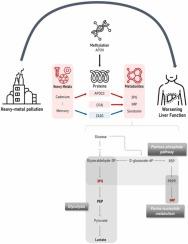重金属暴露及其对 APOC3、CFAI 和 ZA2G 的影响
IF 12.2
1区 环境科学与生态学
Q1 ENGINEERING, ENVIRONMENTAL
引用次数: 0
摘要
尽管重金属污染日益严重,但传统的流行病学往往无法将重金属暴露与健康结果联系起来。这项研究利用多组学研究重金属暴露与健康之间的关联。研究分析了重金属暴露区和对照区 294 名参与者的血液和尿液样本,揭示了关键的生物标志物。元P分析显示,脂蛋白C3(APOC3)的表达趋势一致,中介分析显示,APOC3和锌-α-2-糖蛋白(ZA2G)对代谢物有显著影响:APOC3从血镉到血清素的中介效应为0.023(P<0.001),到3-磷酸甘油酸(3PG)的中介效应为0.0125(P=0.002)。孟德尔随机化证实了 APOC3 和补体因子 I(CFAI)对代谢物的积极影响以及 ZA2G 对代谢物的消极影响,载脂蛋白 H(APOH)甲基化会显著改变 APOC3(β=-0.22,P=0.017)、CFAI(β=0.176,P=0.035)和 ZA2G(β=0.139,P=0.048)蛋白水平。肝功能变量(包括白蛋白、总蛋白、钙和乳酸脱氢酶)与暴露区的 3PG 和血清素水平相关。性别特异性分析表明,男性通过CFAI和肌醇表现出更强的代偿机制,而女性则更容易受到重金属暴露的影响,因此需要采取有针对性的干预措施。这些研究结果表明,APOH甲基化会影响APOC3、CFAI和ZA2G水平,升高3PG、单磷酸肌苷和5-羟色胺水平,并通过脂肪分解损害肝功能。本文章由计算机程序翻译,如有差异,请以英文原文为准。

Heavy metal exposure and its effects on APOC3, CFAI, and ZA2G
Despite increasing heavy metal pollution, traditional epidemiology often fails to link exposure to health outcomes. This study used multi-omics to investigate associations between heavy metal exposure and health. Blood and urine samples from 294 participants in heavy metal-exposed and control areas were analyzed, revealing key biomarkers. Meta P analysis revealed consistent trends in apolipoprotein C3 (APOC3) expression, and mediation analysis showed significant effects of APOC3 and zinc-alpha-2-glycoprotein (ZA2G) on metabolites: the mediating effect of APOC3 from blood cadmium to serotonin was 0.023 (P<0.001) and that to 3-phosphoglyceric acid (3PG) was 0.0125 (P=0.002). Mendelian randomization confirmed the positive impact of APOC3 and Complement Factor I (CFAI) and the negative effect of ZA2G on metabolites, with apolipoprotein H (APOH) methylation significantly altering APOC3 (β=−0.22, P=0.017), CFAI (β=0.176, P=0.035), and ZA2G (β=0.139, P=0.048) protein levels. Liver function variables, including albumin, total protein, calcium, and lactate dehydrogenase, correlated with 3PG and serotonin levels in the exposed areas. Sex-specific analysis showed that men exhibited stronger compensatory mechanisms via CFAI and myo-inositol, while women’s greater vulnerability to heavy metal exposure highlighted the need for targeted interventions. These findings suggest APOH methylation affects APOC3, CFAI, and ZA2G levels, elevating 3PG, inosine monophosphate, and serotonin levels and harming liver function via lipolysis, supporting the use of these markers in health monitoring, therapies, and policies to limit heavy metal risks.
求助全文
通过发布文献求助,成功后即可免费获取论文全文。
去求助
来源期刊

Journal of Hazardous Materials
工程技术-工程:环境
CiteScore
25.40
自引率
5.90%
发文量
3059
审稿时长
58 days
期刊介绍:
The Journal of Hazardous Materials serves as a global platform for promoting cutting-edge research in the field of Environmental Science and Engineering. Our publication features a wide range of articles, including full-length research papers, review articles, and perspectives, with the aim of enhancing our understanding of the dangers and risks associated with various materials concerning public health and the environment. It is important to note that the term "environmental contaminants" refers specifically to substances that pose hazardous effects through contamination, while excluding those that do not have such impacts on the environment or human health. Moreover, we emphasize the distinction between wastes and hazardous materials in order to provide further clarity on the scope of the journal. We have a keen interest in exploring specific compounds and microbial agents that have adverse effects on the environment.
 求助内容:
求助内容: 应助结果提醒方式:
应助结果提醒方式:


